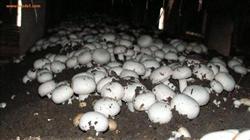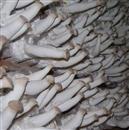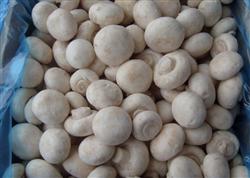Cultivation of Pleurotus ostreatus with biogas residue

1. Base material formula: biogas residue 3000kg, wheat straw or rice straw 3000kg, calcium superphosphate 120kg, urea 18kg, lime powder 180kg, gypsum powder 90kg, light calcium carbonate 30kg, edible mushroom three-dimensional nutrient essence 1440g (12 bags). The formula is suitable for cultivation area of 200 - 220 square meters. 2. Base material fermentation: In addition to three-dimensional essence, wheat straw is directly fermented with fresh biogas residue and auxiliary materials in a heap by stacking one layer of forage, one layer of biogas residue and auxiliary materials. Generally, the width of the pile is 1~ 1.2m and the height is 1.5~ 2m; counting from the date of building the pile, it shall be turned over once every 6 days, 5 days, 4 days and 3 days respectively. A method of turning the pile; spray the pile hours in advance so that the edge grass can absorb enough water. Starting from one end of the material pile, take down the side materials first, make the materials in the high temperature area in the pile as the bottom and top of the new material pile, and turn the side materials, bottom materials and top materials into the middle position of the new material pile. For the third dump, 800 times phoxim solution was sprayed evenly into each layer at a rate of about 5S kg/t dry material to kill pests invading the dump. For the final stack turn, spray the 3-D essence evenly. 3. Bed sowing: After fermentation, spread the pile, adjust the pH value to about 8, and cool it to below 30℃ or normal temperature, then enter the shed. When sowing, sow about 20% of the total amount of strains along the bed base, spread a layer of material with a thickness of about 20 cm, slightly compact to about 10 cm, then sow about 30% of the total amount of strains, spread another layer of material, compact to make the total thickness of about 20 cm, spread 2/3 of the remaining strains to the material surface, and use the "hand grasping method" to sink them into the depth of about 3~5 cm. The rest of the strains can be spread to the material surface and flatten the material surface. After sowing, the mushroom shed vent should be closed to make it in a closed state. Enclosed is not only a temporary ban on ventilation and light shielding, but also to create a quiet environment, conducive to the early recovery of the injured bacteria, germination and colonization. 4. Fungi cover soil: According to the temperature at that time, the closed time of mushroom shed is generally maintained for 3~5 days. After that, when the strain has germinated and the mycelium is mostly between 0.2~0.3 cm, the strain has been planted. Open about 1/4 of the vent hole, so that it slowly ventilated, such as dry can be appropriate spray humidification. After about 20 days, hyphae can be basically full of material, can open the material inspection, more than 2/3 of the thickness of the base material are hyphae densely packed, a small amount has been sent to the bottom of the material, can be covered with soil. The thickness of the covering soil is generally about 3 cm, but it should be mainly determined according to the physical and chemical properties of the covering soil material. If it is peat soil material, the covering thickness can be up to 5 cm, and if it is self-made marsh soil or humus soil material, the covering thickness can be about 3 cm.
- Prev

Cultivation techniques of Pleurotus eryngii
Apricot abalone mushroom (Pleurotuseryngii) is also known as snow mushroom. Pleurotus eryngii is a kind of large fleshy umbrella fungus with good quality. Pleurotus eryngii has thick seedling meat, crisp and tender texture and delicious taste, which can be called the king of Pleurotus ostreatus. Rich in nutrition, high oligosaccharide content, has the effect of bowel cosmetology. It can be suitable for keeping fresh or dried, and is very popular with consumers.
- Next

New technology of cultivating Pleurotus ostreatus with corncob
A large amount of corn is planted in northern China, and corncobs can be used for cultivation of Pleurotus ostreatus after crushing. In recent years, the area of cultivating Pleurotus ostreatus with corncobs has increased rapidly. The content of organic matter in corncob is 91.3%, soluble carbohydrate is 51.8%, and the ratio of carbon to nitrogen is 56.70%. The cultivation area of Pleurotus ostreatus is 100 years old and 200 corncobs can be used.
Related
- Fuxing push coffee new agricultural production and marketing class: lack of small-scale processing plants
- Jujube rice field leisure farm deep ploughing Yilan for five years to create a space for organic food and play
- Nongyu Farm-A trial of organic papaya for brave women with advanced technology
- Four points for attention in the prevention and control of diseases and insect pests of edible fungi
- How to add nutrient solution to Edible Fungi
- Is there any good way to control edible fungus mites?
- Open Inoculation Technology of Edible Fungi
- Is there any clever way to use fertilizer for edible fungus in winter?
- What agents are used to kill the pathogens of edible fungi in the mushroom shed?
- Rapid drying of Edible Fungi

